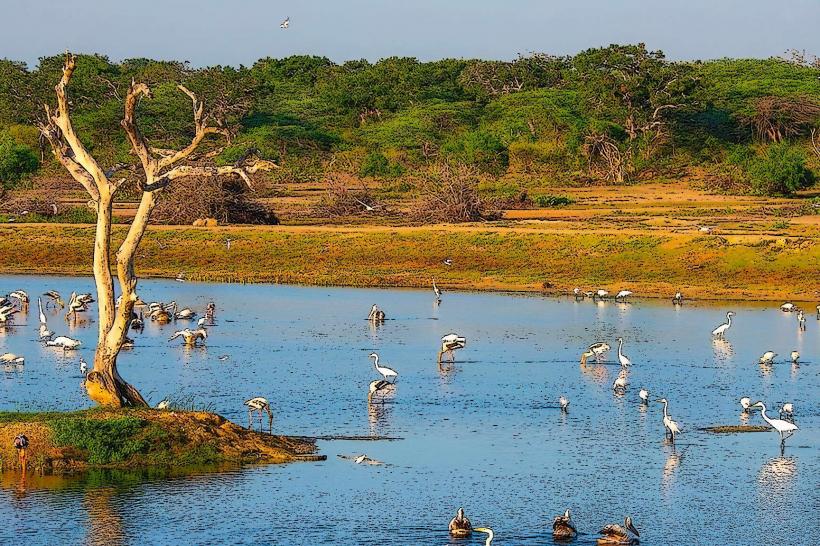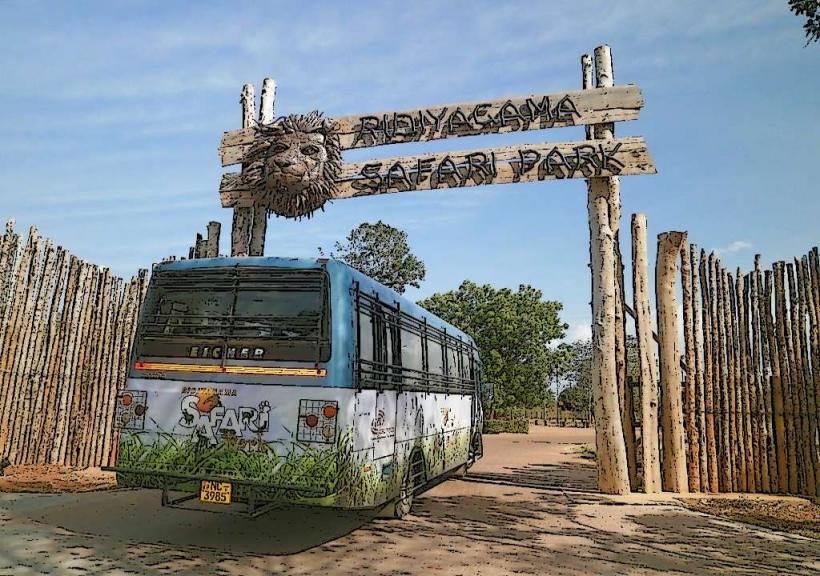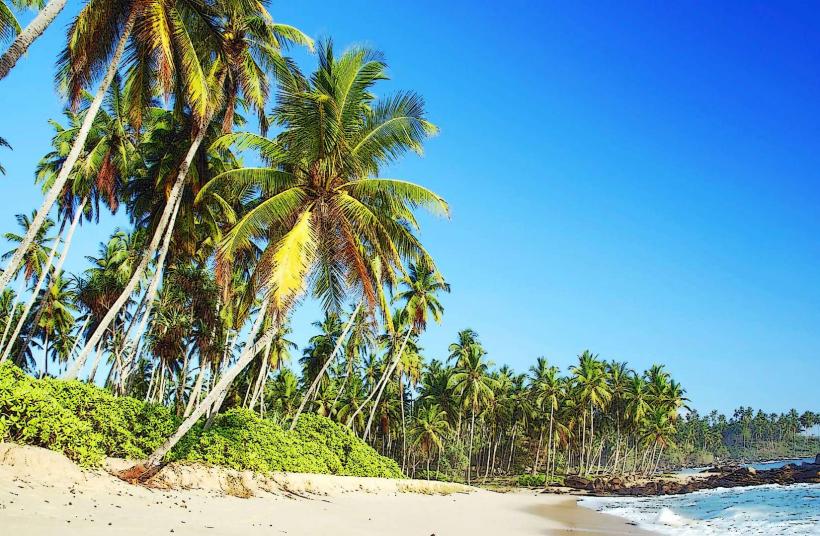Information
Landmark: Yala National ParkCity: Hambantota
Country: Sri Lanka
Continent: Asia
Yala National Park is one of Sri Lanka's most famous and visited national parks, located in the southeastern part of the island. It is renowned for its rich biodiversity, particularly its leopard population, and its significant role in preserving Sri Lanka’s natural heritage. Yala is not only a top destination for wildlife enthusiasts but also offers stunning landscapes, including grasslands, dense forests, wetlands, and coastal habitats.
1. Overview
- Location: Yala National Park is situated in the Southern Province of Sri Lanka, approximately 300 kilometers southeast of Colombo. The park is located in close proximity to Tissamaharama and Hambantota.
- Size: Covering an area of 979 square kilometers (378 square miles), Yala is the second-largest national park in Sri Lanka. It is divided into several blocks, with Block I being the most visited and popular section for safaris.
- Designation: Yala was designated as a national park in 1938 and has since become a key part of Sri Lanka’s efforts to conserve its biodiversity. It is also a Biosphere Reserve and a Ramsar Wetland due to its ecological importance.
2. Features and Biodiversity
Flora
- Vegetation Zones: Yala features diverse ecosystems, from dry zone forests to scrublands, grasslands, and wetlands. These varying habitats support different types of plant life, including tropical dry evergreen forests, thorny scrub, and riverine forests.
- Vegetation: The park is home to a wide variety of plant species, including mango trees, palmyra palms, coconut palms, acacia trees, and shrubs that thrive in the dry conditions.
Fauna
Yala is one of the best places to spot a wide array of animals, including the famous Sri Lankan leopard and numerous other species.
- Sri Lankan Leopard (Panthera pardus kotiya): Yala is one of the best places in the world to see the elusive Sri Lankan leopard, which is considered a sub-species of the Asian leopard. Yala boasts one of the highest leopard densities in the world, making it a top destination for wildlife photographers and safari enthusiasts.
- Mammals: In addition to the leopard, Yala is home to a variety of mammals, including:
- Asian elephants (which are often seen grazing in the park’s grasslands and near water sources),
- Sri Lankan sloth bear (rarely spotted but present in the park),
- Cinnamon bear,
- Wild boar,
- Spotted deer (also known as Cheetal),
- Sambar deer,
- Gray langur monkeys, and
- Mongoose.
- Birdlife: Yala is a prime destination for birdwatching, with over 200 species of birds recorded in the park, including both resident and migratory species. Some of the notable birds include:
- Indian Peafowl (Sri Lanka’s national bird),
- Painted Stork,
- Spot-billed pelican,
- Crested hawk-eagle,
- Cuckoos,
- Hornbills, and
- Kingfishers.
- Reptiles and Amphibians: Yala also has a variety of reptiles, including monitor lizards, mugger crocodiles, king cobras, and other species of snakes and turtles.
- Marine Life: The park’s coastal areas are home to sea turtles, including the Olive Ridley and Green sea turtles, which nest along the beaches.
3. Attractions and Activities
Wildlife Safaris
- Safari Drives: The most popular activity in Yala National Park is a jeep safari, where visitors can explore the park’s diverse landscapes and spot its wildlife. Guided safaris are available, and experienced naturalists or park rangers accompany visitors, providing insights into the park’s flora and fauna.
- Leopard Watching: Yala is particularly famous for its high leopard population. Visitors on safari are likely to see leopards, especially in early mornings or late afternoons, when they are most active.
- Elephant Watching: Elephants are also a common sight in Yala, particularly in waterholes and open grasslands. The park is home to a large number of elephants, and visitors often encounter these majestic creatures during safaris.
- Birdwatching: Birdwatchers flock to Yala for its abundant birdlife, especially during the migratory season (from November to April), when species from across Asia and Europe migrate through the park.
Eco-Tours
- Nature Walks and Treks: Some parts of Yala offer nature walks and trekking opportunities, led by local guides who explain the park’s ecosystems and wildlife. This is a great way to explore the flora and smaller creatures of the park.
- Beach Visits: Yala has a coastal region with pristine beaches where visitors can relax or watch sea turtles nesting on the sand. The beaches provide beautiful views of the Indian Ocean and add to the park’s diversity of ecosystems.
4. Best Time to Visit
- Ideal Visiting Season: The best time to visit Yala is during the dry season, from February to June, when the park’s wildlife is concentrated around the limited water sources, making it easier to spot animals. The weather is typically sunny and warm, and the park is less affected by rain.
- Rainy Season: From October to January, the monsoon season brings rain, which can make certain parts of the park harder to access. However, this time can still be good for birdwatching, as the wet season is when migratory birds arrive.
- Leopard Sightings: The dry months are considered the best for spotting leopards, as the cats are more likely to be visible in the open spaces near water sources.
5. Accommodation and Amenities
- Nearby Accommodation: There are a variety of accommodation options in the towns surrounding Yala National Park, such as Tissamaharama, Kirinda, and Hambantota. These include luxury resorts, eco-lodges, and guesthouses, catering to different budgets.
- Park Accommodation: There are also a few eco-lodges and campsites near the park where visitors can experience a more immersive nature stay.
- Dining Options: Restaurants and lodges near the park offer a variety of Sri Lankan cuisine, including rice and curry, seafood, and local snacks.
6. Access and Transportation
- Getting There: Yala is accessible by car or jeep from Tissamaharama, which is the nearest town. Visitors can hire taxis or use private transport to reach the park’s entrance.
- Public Transport: Public buses are available to Tissamaharama from Colombo and Galle, but hiring a private vehicle is recommended for easier access to the park and to make the most of the experience.
- Safari Access: Once inside the park, safaris are conducted in jeeps or 4x4 vehicles. Visitors must book safaris in advance, especially during peak seasons, as there are limited vehicles allowed inside the park at a time.
7. Conclusion
Yala National Park is a must-visit destination for wildlife lovers and nature enthusiasts. With its diverse ecosystems, high leopard density, and wide variety of flora and fauna, the park offers an unforgettable experience. Whether you are interested in safaris, birdwatching, or simply exploring its stunning landscapes, Yala is one of Sri Lanka’s premier wildlife parks and a top location for those wanting to connect with nature and wildlife. It provides a thrilling and educational experience that is both exciting and enriching.




